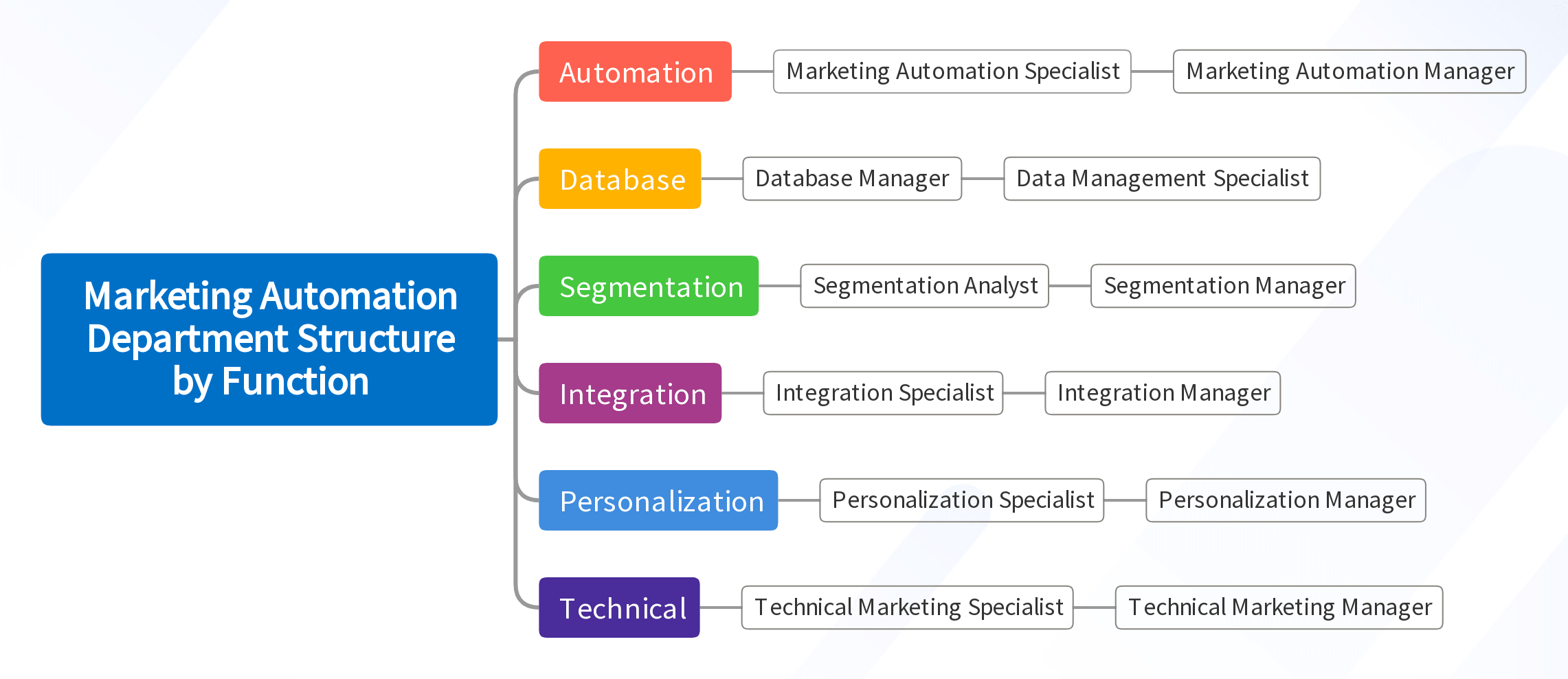

At the heart of modern business sits Marketing Automation. This dynamic team plays a crucial role in today's fast-paced economy.
Understanding how to structure such a team is vital. It shapes success in an increasingly digital world. I speak from experience from running my own marketing agency, GrantSpark.
But first, let's talk about the Marketing Automation department structures you have to choose from.
Best for Growth Marketers
Best for Paid Ads & CMO's
Table of Contents
Structuring Marketing Automation Department
There are two main types of department structures based on company size and resources.
- Marketing Automation department structure by discipline
- Org Type: Traditional corporate departments
- Best For: Midsize/Enterprise companies
- Marketing Automation department structure by function
- Org Type: Employees are grouped by activities and objectives
- Best For: Small to Medium Sized Business (SMB)
Let’s go in-depth to each one of them.
1. Marketing Automation Department Structure by Discipline


Discipline-based structure involves building teams centered around various marketing disciplines. For example, SEO, Content, Market Research, and Product Strategy could each form separate teams within a department.
| Discipline | Key Skills | Potential Roles |
|---|---|---|
| Strategy | Market Research, Data Analysis, Strategic Planning, Brand Management | Marketing Automation Strategist, Brand Strategist |
| Content | Content Creation, SEO, Copywriting, Content Strategy | Content Manager, SEO Specialist, Copywriter |
| Email Campaign Management, Copywriting, Data Analysis, Email Strategy | Email Marketing Specialist, Email Campaign Manager | |
| Analytics | Data Analysis, Market Research, Statistics, Reporting | Data Analyst, Market Research Analyst |
| Social Media | Social Media Strategy, Content Creation, Community Management, Analytics | Social Media Manager, Community Manager |
| CRM | CRM Management, Data Analysis, Customer Segmentation, Relationship Management | CRM Manager, Customer Success Manager |
| Lead Generation | Lead Generation Strategies, Data Analysis, Sales Funnel Management, Conversion Optimization | Lead Generation Specialist, Conversion Rate Optimization Specialist |
| Web Development | Web Design, UX/UI Design, HTML/CSS, JavaScript | Web Developer, UX/UI Designer |
2. Marketing Automation Department Structure by Function


Another approach is structuring by function, where teams are formed based on the different functions they perform. For example, promotion, launches, and relationship management could all be separate teams.
| Function | Key Skills | Potential Roles |
|---|---|---|
| Automation | Marketing Automation Tools, Data Analysis, Campaign Management, CRM | Marketing Automation Specialist, Marketing Automation Manager |
| Database | Data Management, SQL, CRM, Data Analysis | Database Manager, Data Management Specialist |
| Segmentation | Customer Segmentation, Data Analysis, CRM, Market Research | Segmentation Analyst, Segmentation Manager |
| Integration | CRM, Marketing Automation Tools, API Management, Data Management | Integration Specialist, Integration Manager |
| Personalization | Customer Segmentation, Personalization Strategies, CRM, Data Analysis | Personalization Specialist, Personalization Manager |
| Technical | Marketing Automation Tools, API Management, HTML/CSS, JavaScript | Technical Marketing Specialist, Technical Marketing Manager |
Marketing Automation Team Size versus Business Scale
To achieve successful marketing outcomes, you need to align the team size with your business's scale – a strategic approach that helps optimize resources and drive targeted growth.
| Business Scale | Ideal Department Size | Explanation |
|---|---|---|
| Start-up | 1-2 | Minimal resources, focus on key tasks. |
| Small-Medium Business | 3-5 | Expanded needs, more customer segmentation. |
| Large Enterprise | 6+ | High complexity, extensive campaigns & segmentation. |
Factors to Consider When Deciding On a Marketing Automation Department Structure
- Understand Business Goals: Know the objectives of your organization. This understanding will help you align your marketing automation strategy with the broader business goals and drive success.
- Evaluate Current Processes: Assess existing marketing practices. This will enable you to identify areas that can be automated to improve efficiency and results.
- Identify Required Skills: Determine the skills you need in your team. Marketing automation requires a mix of technical and creative talents, including expertise in data analysis, content creation, and customer engagement.
- Consider Technological Infrastructure: Consider your company's current technological capacity. Your infrastructure should support the automation tools and software you plan to implement. If not, you may need to invest in upgrading or acquiring new technologies.
- Plan for Scalability: Plan your marketing automation strategy with future growth in mind. As your business expands, your marketing automation needs will also grow. Your structure should be able to scale and adapt to changing requirements.
Explore other marketing departments:
So, there you have it, a detailed overview of a Marketing Automation team structure. From the essence of the team and key roles, to structuring and optimizing; every aspect tailored to achieve success on your business blueprint.


















